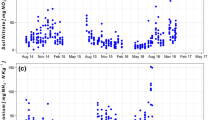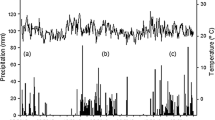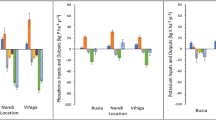Abstract
The flows and balances of N, P and K were studied in 20 farms in the Campo Ma’an area in Cameroon between March and August 2002 to assess the nutrient dynamics in smallholder farms. Data were collected through farmer interviews, field measurements and estimates from transfer functions. Nutrient input from mineral (IN1), animal feed (IN2a) and inorganic amendments (IN2b) was absent. Major outputs were through crop (OUT1a) and animal (OUT1b) products sold. Partial budgets for farmer managed flows were negative: −65 kg N, −5.5 kg P and −30.8 kg K ha−1 year−1. For inflows not managed by farmers, deep capture (IN6) was the major source: 16.6, 1.4 and 6.6 kg ha−1 year−1 of N, P and K, respectively. Atmospheric deposition (IN3) was estimated at 4.3 kg N, 1.0 kg P and 3.9 kg K ha−1 year−1, and biological nitrogen fixation (IN4) at 6.9 kg N ha−1 year−1. Major losses were leaching (OUT 3a): 26.4 kg N, and 0.88 kg K ha−1 year−1. Gaseous losses from the soil (OUT 4a) were estimated at 6.34 kg N, and human faeces (OUT 6) were estimated at 4 kg N, 0.64 kg P and 4.8 kg K ha−1 year−1. The highest losses were from burning (OUT 4c), i.e. 47.8 kg N, 1.8 kg P and 14.3 kg K ha−1 year−1. Partial budgets of environmentally controlled flows were negative only for N −4.8 kg N, +2.4 kg P and +9.6 kg K ha−1 year−1. The overall farm budgets were negative, with annual losses of 69 kg N, 3 kg P and 21 kg K ha−1. Only cocoa had a positive nutrient balance: +9.3 kg N, +1.4 kg P and +7.6 kg K ha−1 year−1. Nutrients reaching the household waste (1.9 kg N, 2.8 kg P and 18.8 kg K ha−1 year−1), animal manure (4.9 kg N, 0.4 kg P and 1.6 kg K), and human faeces (4 kg N, 0.64 kg P and 4.8 kg K ha−1 year−1) were not recycled. Five alternative management scenarios were envisaged to improve the nutrient balances. Recycling animal manure, household waste and human faeces will bring the balance at −62.6 kg N, 0 kg P and +1 kg K ha−1 year−1. If, additionally, burning could be avoided, positive nutrient balances could be expected.
Similar content being viewed by others
References
Anderson J.M. and Ingram J.S.I. (1993). Tropical Soil Biology and Fertility: A Handbook of Methods. CAB International, Oxon, UK .
Baijukya F.P. and De Steenhuijsen P.B. (1998). Nutrient balances and their consequences in the banana based land use systems of Bukoba districtNorth West Tanzania. Agricult. Ecosyst. Environ. 71: 147–158 .
Barrow N.J. (1987). Return of nutrients by animals. In: Synadon, R.W. (eds) Managed Grasslands, pp. Oxford, Elsevier .
Bationo A., Lompo F. and Koala S. (1998). Research on nutrient flows and balances in west Africa: state-of-the-art. Agricult. Ecosyst. Environ. 1: 19–35 .
Büttner U. and Hauser S. (2003). Farmer's nutrient management practices in indigenous cropping systems in southern Cameroon. Agricult. Ecosyst. Environ. 100(2–3): 103–110 .
Deugd M., Roling N. and Smaling E.M.A. (1998). A new praxeology for integrated nutrient managementfacilitating innovation with and by farmers. Agricult. Ecosyst. Environ. 71: 269–283 .
Haynes R.J. and Williams P.H. (1993). Nutrient cycling and soil fertility in grazed pasture ecosystems. Adv. Agronom. 49: 119–199 .
Hoffman I., Gerling D., Kyogwom U.B. and Mane-Bielfeldt (2001). Farmers’ management strategies to maintain soil fertility in a remote area in northwest Nigeria. Agricult. Ecosyst. Environ. 86(3): 263–275 .
Hölscher D., Möller R.F., Denich M. and Fölster H. (1997). Nutrients input–output brudget of shifting cultivation in Eastern Amazonia. Nutrient Cycling Agroecosyst. 47: 49–57 .
Janssen B.H., Noij I.G.A.M., Wesselink L.G. and Grinsven J.J.M. (1990). Stimulation of the dynamics of nutrients and moisture in tropical ecosystems. Fert. Res. 26: 145–156 .
Juo A.S.R. and Manu A. (1996). Chemical dynamics in slash-and-burn agriculture. Agricult. Ecosyst. Environ. 58: 49–60 .
Kotto-Same J., Woomer P.L., Moukam A. and Zapfack L. (1997). Carbon dynamics in slash-and-burn agricultureand land-use alternatives of the humid forest zone in Cameroon. Agricult. Ecosyst. Environ. 65(3): 245–256 .
Nye P.H. and Greenland D.J. 1960. The soil under shifting cultivation. Technical Communication 51, Commonwealth Bureau of Soil, Harpenden, UK..
Oenema O., Kros H. and Vries W. (2003). Approaches and uncertainties in nutrient budgets: implications for nutrient management and environmental policies. Eur. J. Agron. 20: 3–16 .
Sanginga N., Lyasse O., Diels J. and Merckx R. (2003). Balanced nutrient management systems for cropping systems in the tropics: from concept to practice. Agricult. Ecosyst. Environ. 100(2–3): 99–102 .
Smaling E.M.A. 1993. An Agroecological Framework for Integrated Nutrient Management with Special Reference to Kenya. Wageningen Agricultural University, Wageningen, The Netherlands, (Ph.D. thesis)..
Smaling E.M.A., Stoorvogel J.J. and Windmeijer P.N. (1993). Calculating soil nutrient balances in Africa at different scales. II District scale. Fert. Res. 35: 237–250 .
Smaling E.M.A., Fresco L.O. and de Jager A. 1996. Classifying, monitoring and improving soil nutrient stocks and flows in Africa agriculture. Ambio 25(8): 492–496..
Stoorvogel J.J. and Smaling E.M.A. 1990. Assessment of soil nutrient depletion in sub-Saharan Africa1983–2000. Report 28. The Winand Centre for Integrated LandSoil and Water Research (SC- DLO) Wageningen.
Szott L.T. 1995. Growth and biomass production of nitrogen fixing trees on acid soils. In: Evans D.O. and Szott L.T.(eds) Nitrogen Fixing Trees for Acid Soils. Proceedings of a workshop organized by NTFA and CATIE held in Costa Rica July 3–8 1994 in TurrialbaUSANFT Research Report Arkansas..
Tchoumboue J. 1980. Rôle des déjections animales dans la pollution de l’environnement. Animation ScientifiqueDépartement de Zootechnie, ENSA Yaoundé..
Gitari J.N., Ogaro V.M., Maobe S., Vlaming J. and Bosch H. (1998). Monitoring nutrient flows and economic performance in Africa farming systems (NUTMON). III. Monitoring nutrient flows and balances in the districts in Kenya. Agric Ecosyst. Environ. 71: 63–80.
Westphal E., Embrechts J., Mbouemboue P. Mouzong Boyomoet and Westphal-stevels J. M.C. 1981. l’Agricuture autochtone au Cameroun: les techniques culturales, les séquences de cultureles plantes alimentaires et leur consommation, Miscellaneous papers 20 Landbouwhogeschool Wageningen, The Netherlands.
Author information
Authors and Affiliations
Corresponding author
Rights and permissions
About this article
Cite this article
Kanmegne, J., Smaling, E.M.A., Brussaard, L. et al. Nutrient flows in smallholder production systems in the humid forest zone of southern Cameroon. Nutr Cycl Agroecosyst 76, 233–248 (2006). https://doi.org/10.1007/s10705-005-8312-3
Received:
Accepted:
Published:
Issue Date:
DOI: https://doi.org/10.1007/s10705-005-8312-3




